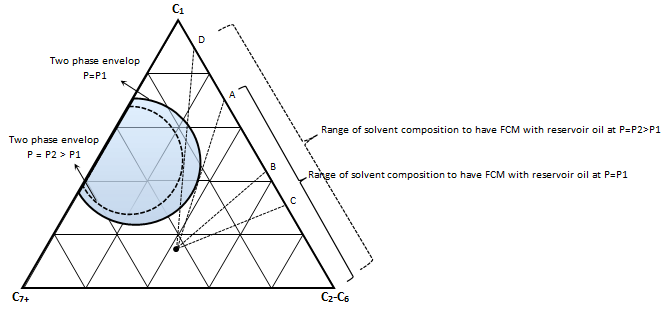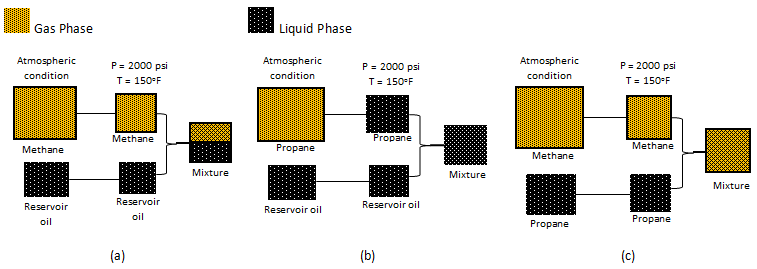Fundamentals of Fluid Flow in Porous Media
Chapter 5
Miscible Displacement
First Contact Miscibility Process
Two fluid phases are said to be first contact miscible (FCM) if, when mixed together in any proportion at given conditions, they form a single phase. In oil field practice a FCM process normally consists of injecting a relatively small primary slug that is miscible with the reservoir oil, followed by injection of a larger, less expensive secondary slug. Economic issues determined the primary slug size. To avoid trapping of the injected solvent in the reservoir the secondary slug tried to be miscible with the solvent in the first slug. Therefore phase behavior should be attended for the leading and trailing edges of the primary slug. Ternary diagram could be used to illustrate FCM, MCM and immiscibility condition. If a straight line dilution path between the solvent and the crude does not intersect the two-phase region, the displacement will consist of a single hydrocarbon phase that change in composition from reservoir oil to solvent through the solvent oil mixing zone. There is a range of solvent composition that will be first contact miscible with the crude at specific temperature and pressure (Figure 5‑14).

Figure 5-14: First Contact Miscibility
First contact miscibility can be achieved for highly rich gas, or at very high pressure for lean gas. As Figure 5‑14 shows, higher-molecular-weight hydrocarbons, such as propane or LPG, are miscible with crude oil, at most reservoir conditions. Reservoir porous medium could be assumed as a series of finite well-mixed cells. Figure 5‑15 typically illustrate the miscible and immiscible oil flooding by using a well-mixed cell. Methane is a gas at reservoir condition and it doesn’t mix with the oil in all proportion and two phase exist. So crude oil displacement with methane is an immiscible flood (Figure 5‑15.a).propane is gas at atmospheric condition however it would be a liquid phase at reservoir condition. Liquid propane and liquid crude oil mix together completely. The displacement of oil with propane at the specified condition would be a miscible process (Figure 5‑15.b). Propane and butane exist as a gas at atmospheric condition. At the reservoir condition (such as P=2000 psi and T=150°F) propane is liquefied but the methane remains as a gas phase. At this condition they mix together in all proportions. So displacement of propane with methane at the specified condition would be a FCM displacement (Figure 5‑15.c). To use LPG products such as ethane, propane and butane, pressure is required to liquefied the LPG products and achieve FCM with the reservoir oil. On the other hand LPG products are injected as a slug that is followed by a chase gas such as lean gas or flue gas. To decrease LPG residual saturation after displacing the primary slug with chase gas the pressure should be high enough to achieve FCM between chase gas and LPG as well as between reservoir oil and LPG. The required pressure to achieve miscibility between the chase gas and the LPG slug is much higher than the pressure required liquefying LPG hydrocarbons. So the controlling pressure during the miscible flooding of the oil with LPG slug is the minimum pressure required to have FCM between LPG slug and chase gas.
If you have any questions at all, please feel free to ask PERM! We are here to help the community.
Figure 5-15: Miscibility and Immiscibility Illustration Using Well-Mixed CellsReferences
Questions?
